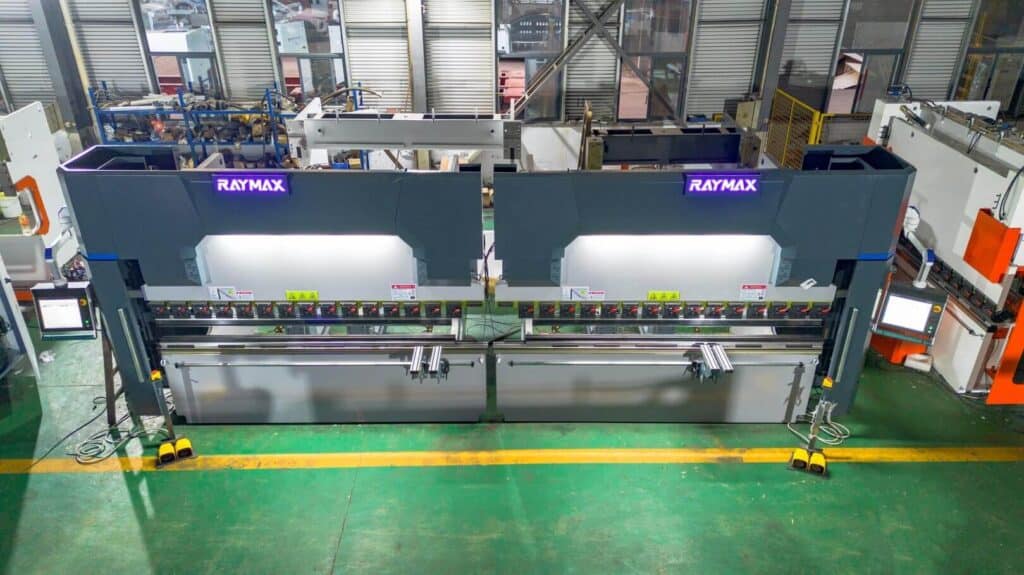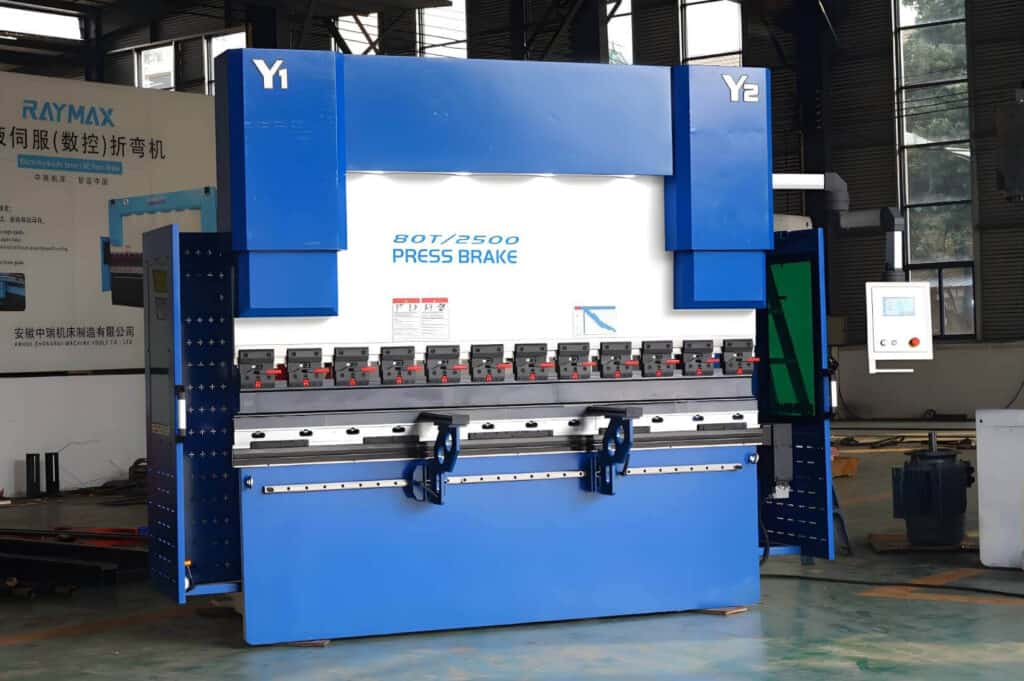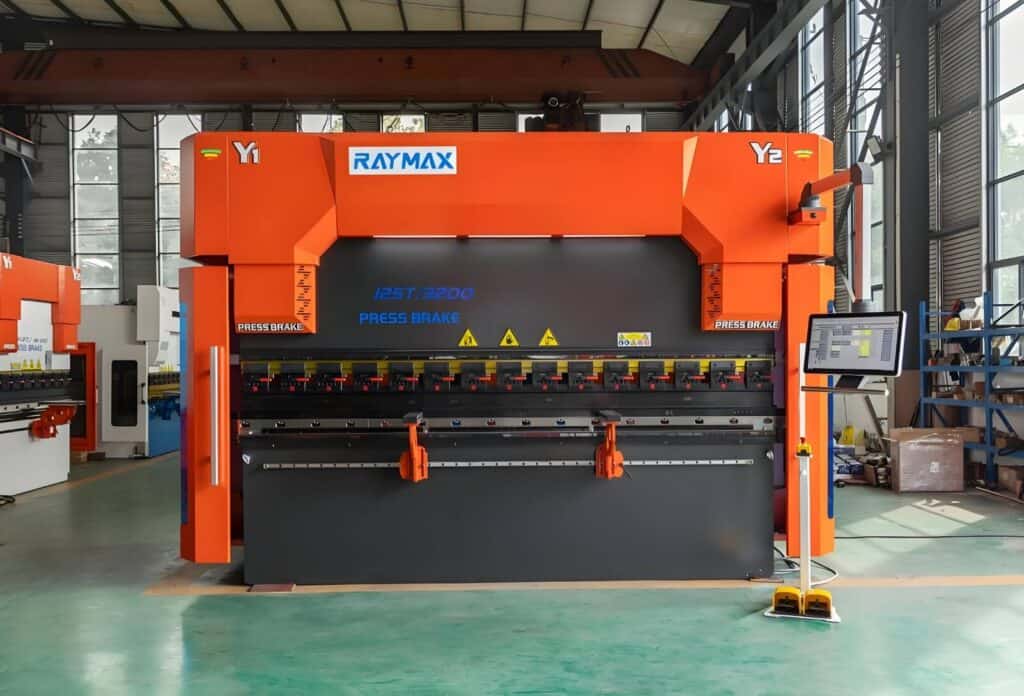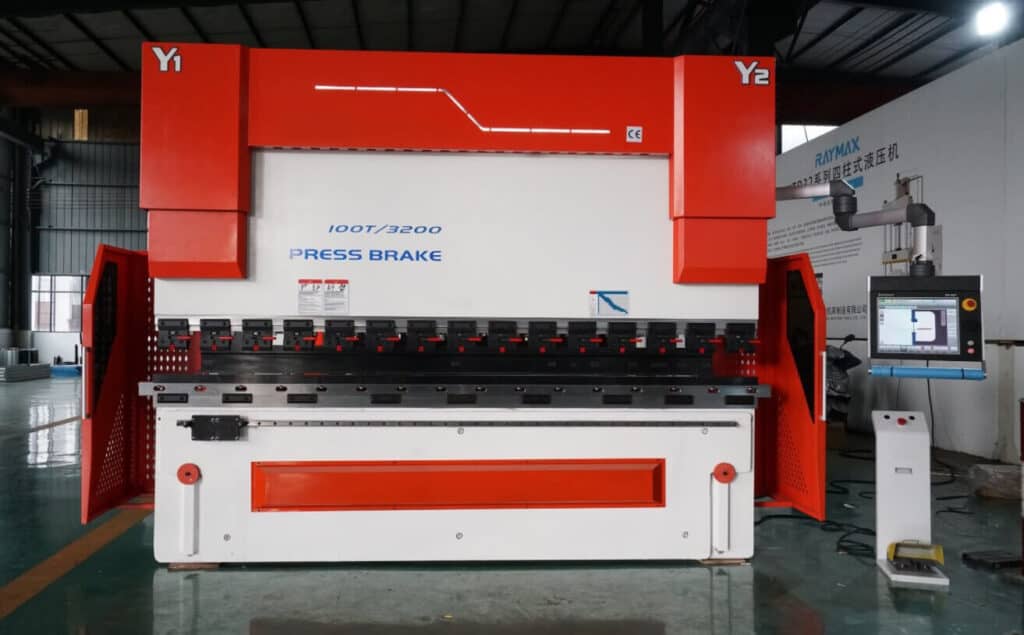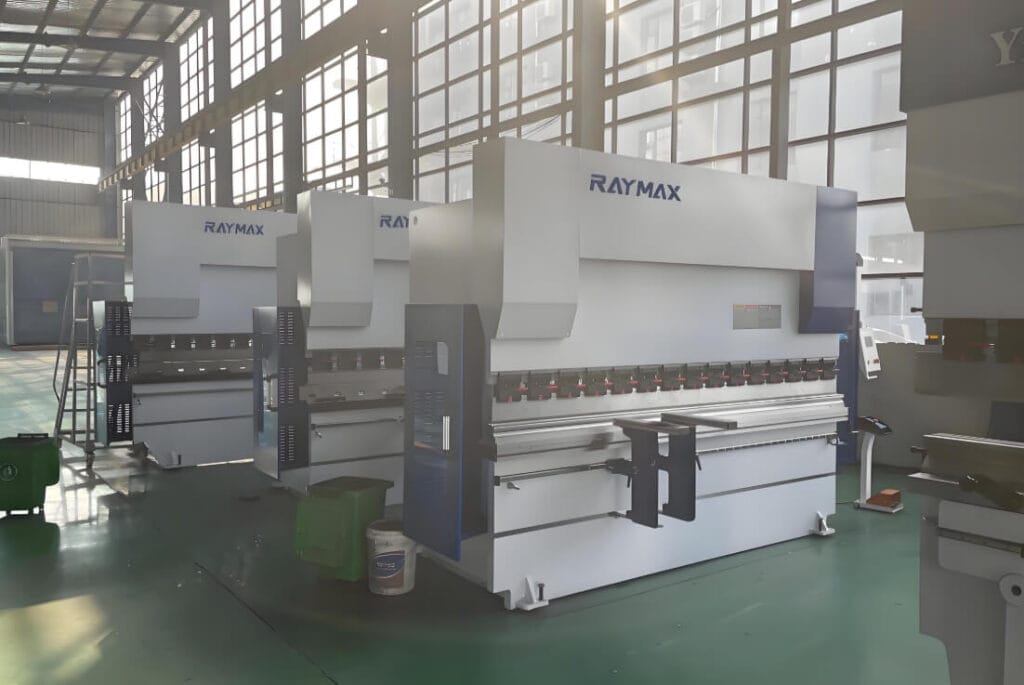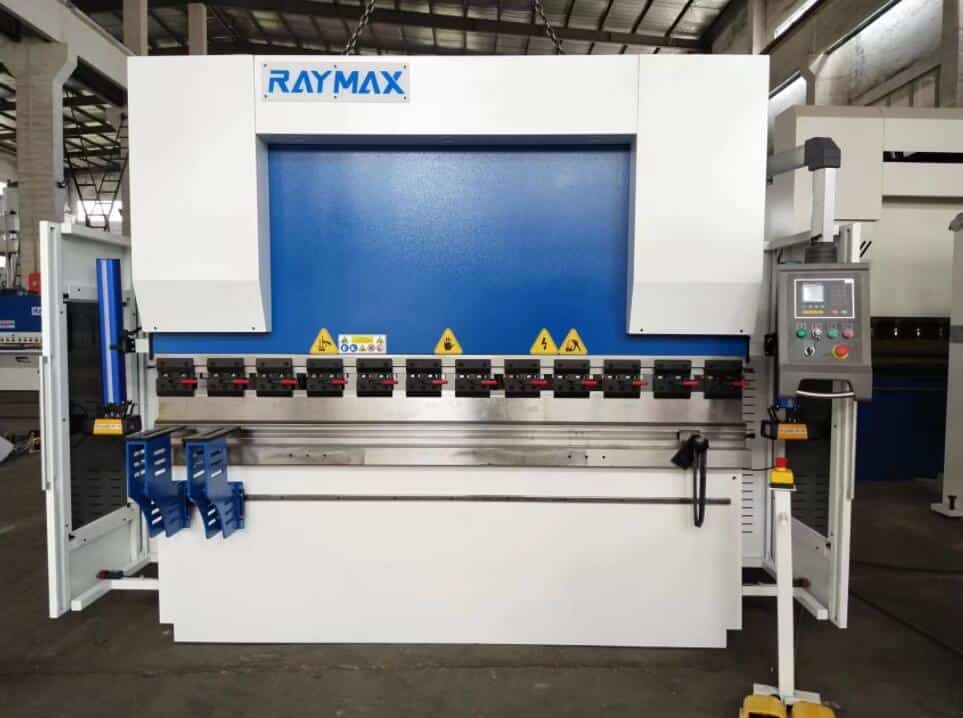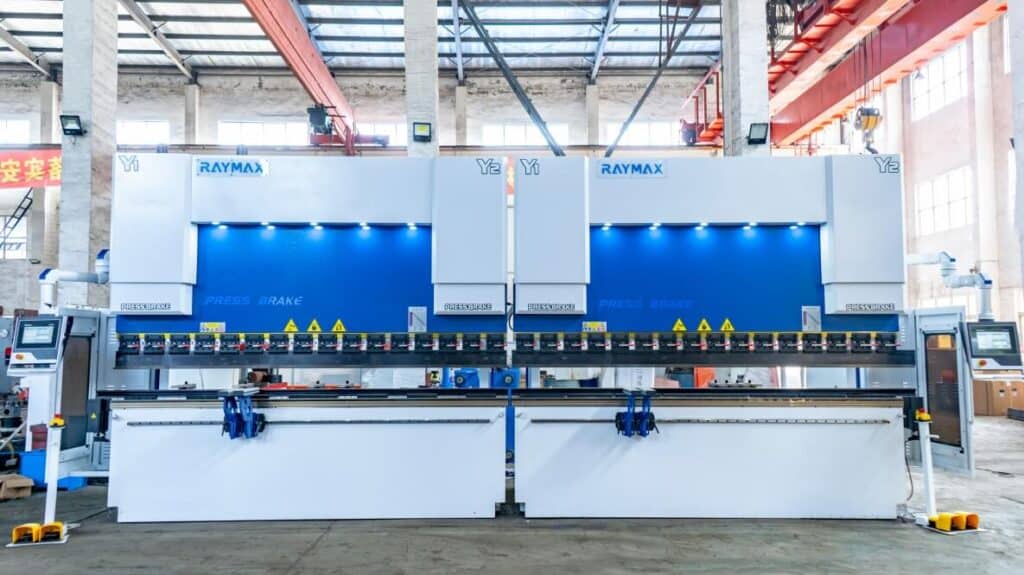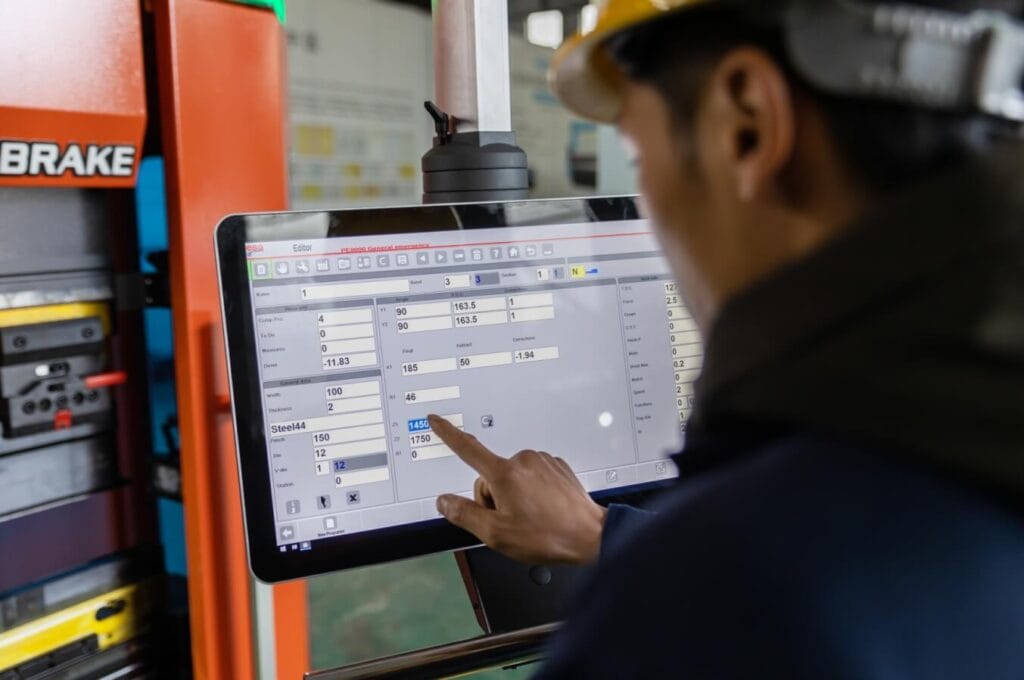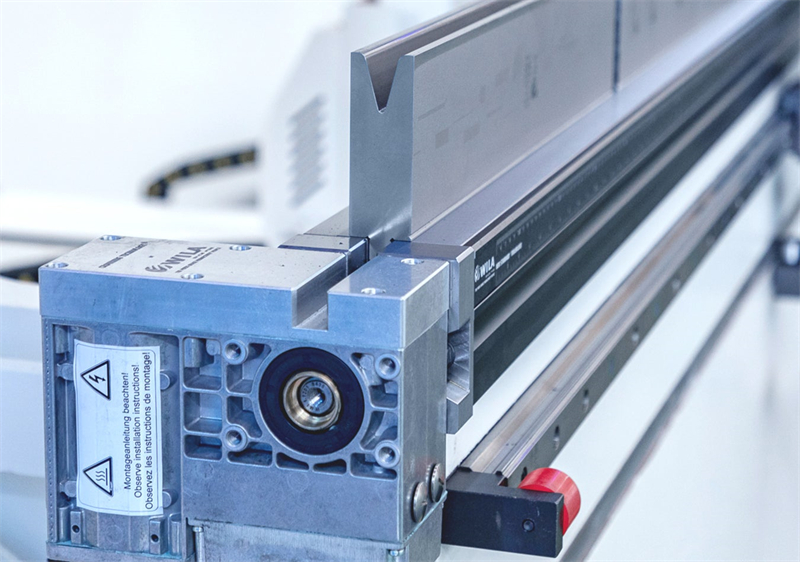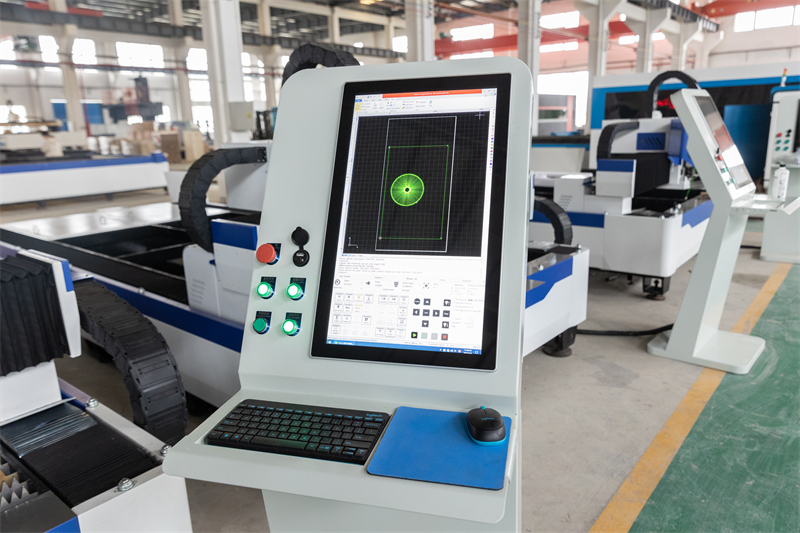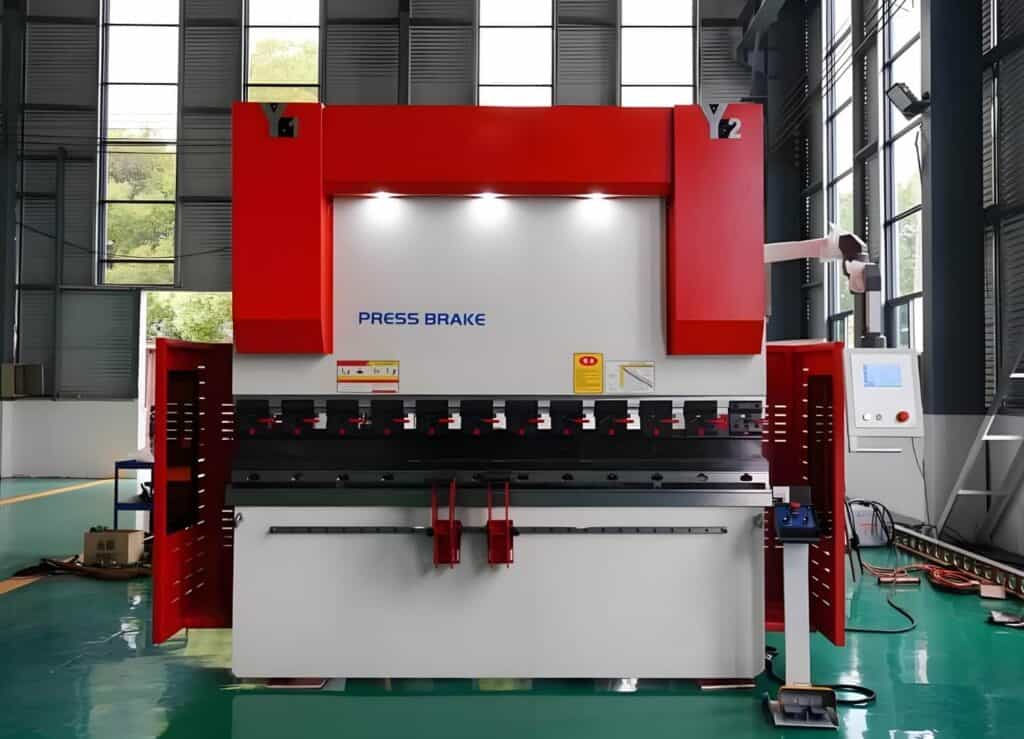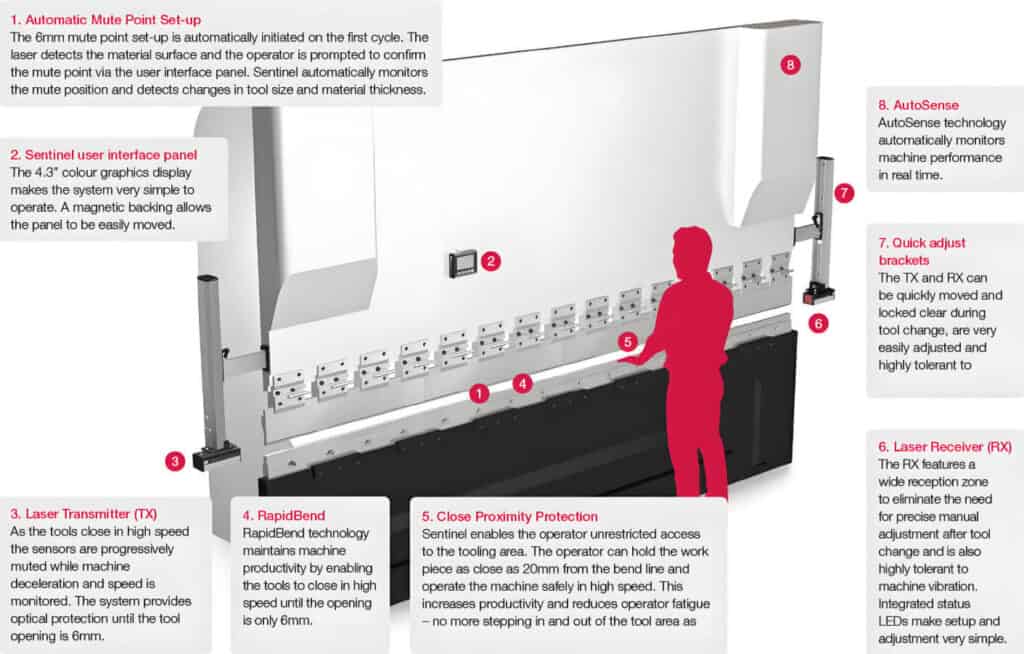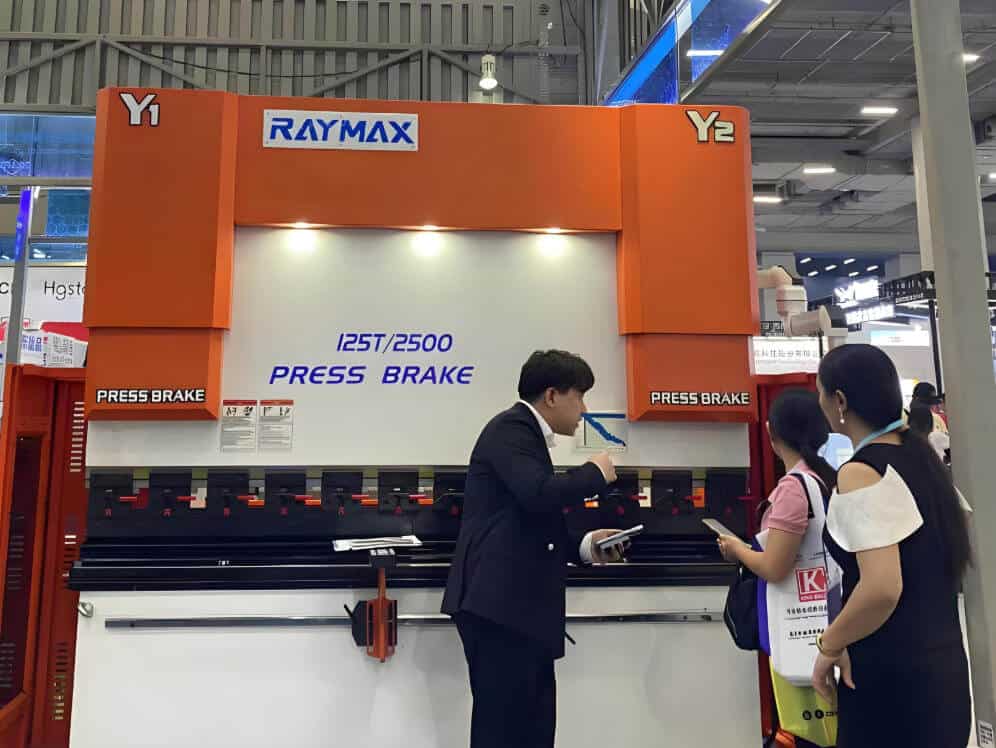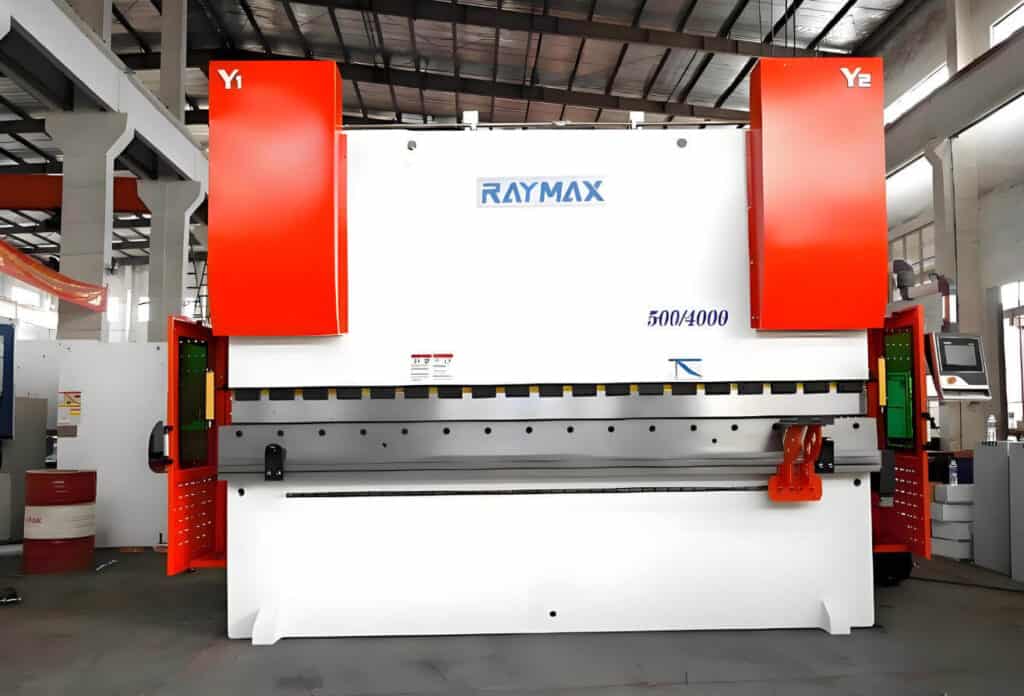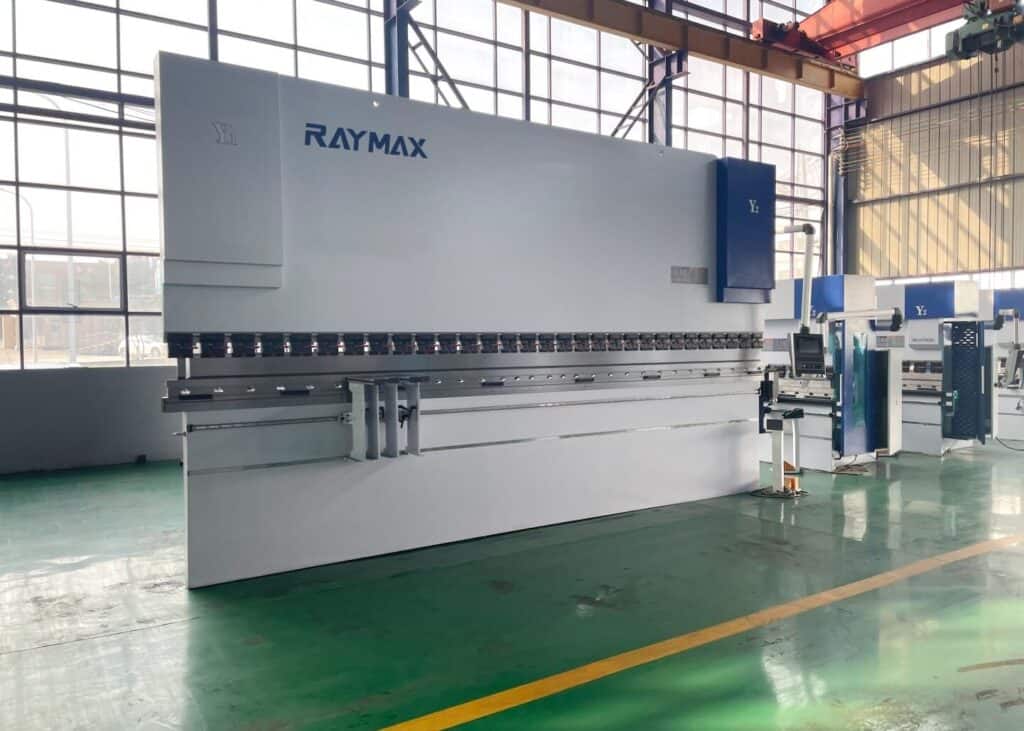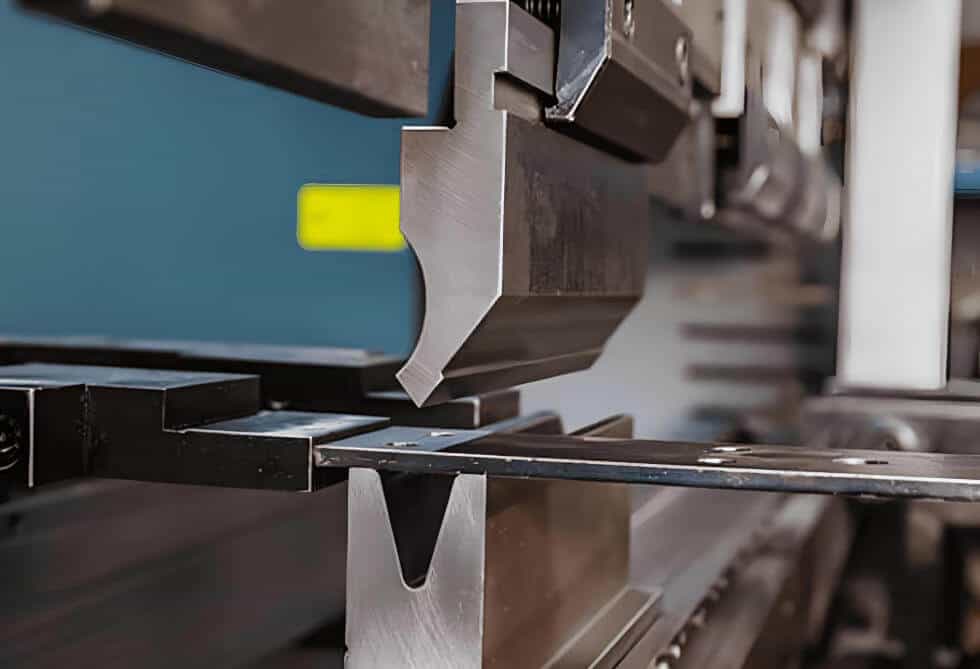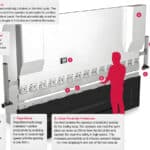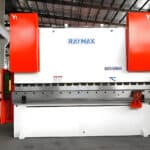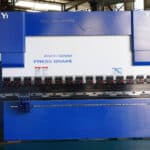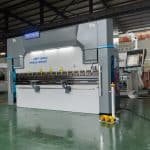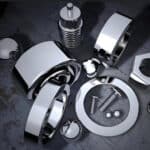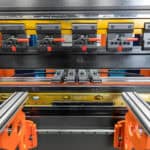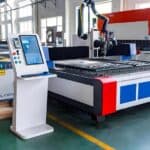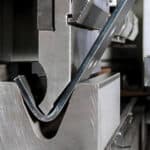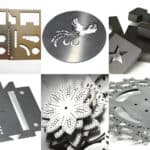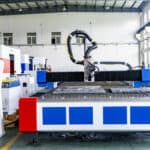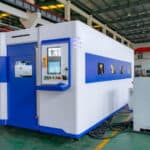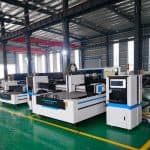1. Introduction
In the field of metal processing, press brake and metal thickness are two concepts. As a mechanical press, press brake bending machine is mainly responsible for the bending and forming of metal sheets. Metal thickness, that is, the vertical thickness of metal sheets, is a key parameter that affects processes such as bending, cutting, and forming.
Metal thickness is directly related to the selection and bending performance of the brake press. Metals of different thicknesses require press brakes of different models and performances to handle, which will also affect the bending process and final effect. Understanding the significance of common metals and their thickness levels to the process, mastering bending tonnage calculations, process parameters, and on-site solutions are essential to improving the efficiency and quality of metal processing.
This article aims to help manufacturing personnel gain an in-depth understanding of the impact of different metal thicknesses on bending operations, so that they can make more reasonable decisions when selecting and configuring press brakes, thereby improving production efficiency and product quality.
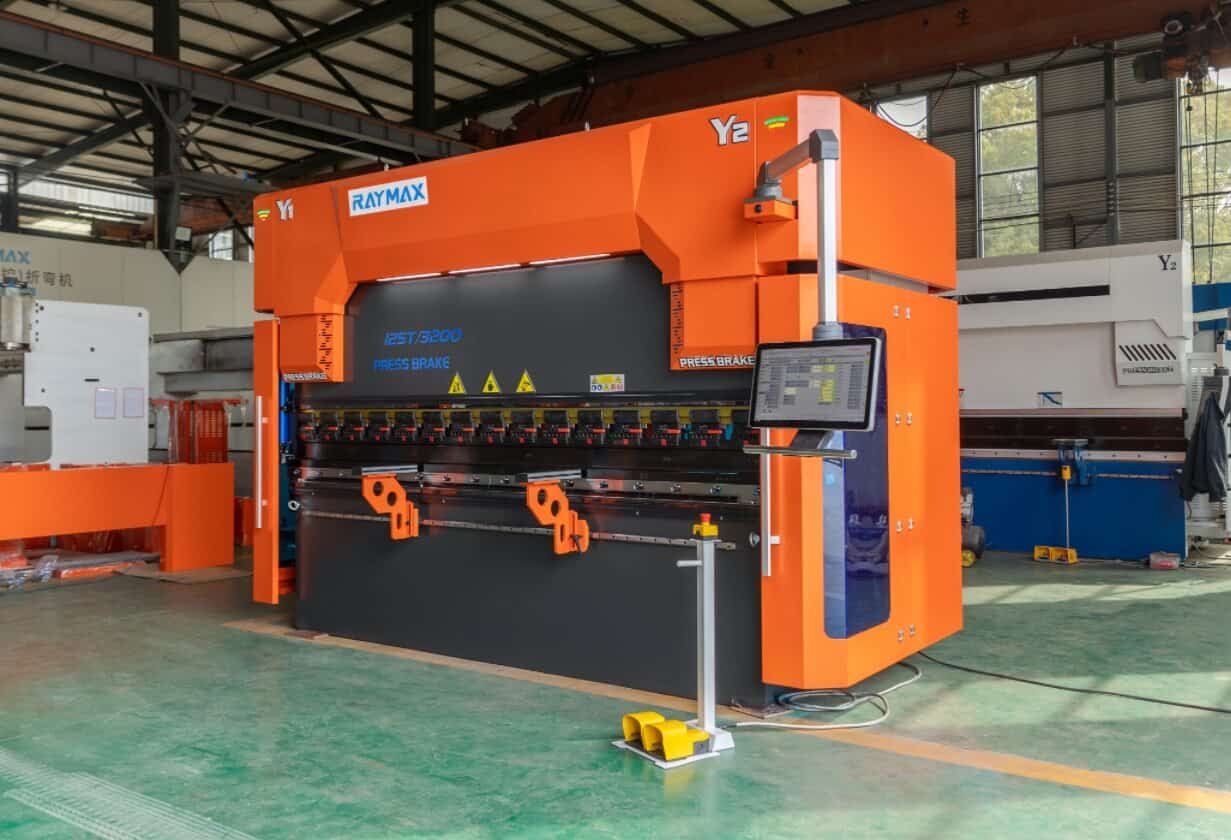
2. Basic knowledge of metal thickness of press brakes
2.1 The importance of metal thickness to the selection of press brakes
Material thickness plays a decisive role in choosing the right brake press and press brake tool. Thicker materials require higher tonnage press brakes. If you choose a low-tonnage brake press, it will not only damage the machine and increase maintenance costs, but also affect the uniform and accurate bending effect of the material.
2.2 Common units of metal thickness (mm and inch)
In the industry, the commonly used units for measuring metal thickness are millimeters (mm) and inches (inch). Millimeters are widely used in most Asian and European factories, while the imperial unit inch is more common in North America. The conversion relationship between them is 1 inch = 25.4 mm. In addition, in addition to feet, the United States also often uses Gauge (American Standard) to indicate metal thickness. In practical applications, these counting units usually need to be converted.
2.3 General classification of metal thickness and its industry standards
2.3.1 Thin plate: refers to the thickness range of 0.5mm – 3mm, such as home appliance housings often use thin plates.
2.3.2 Medium plate: refers to the thickness between 3mm – 10mm, which can be used for mechanical housings.
2.3.3 Thick plate: refers to metal with a thickness of 10mm – 20mm and above, which is often used in heavy machinery, etc. Different
2.3.4 Other thicknesses: JIS, GB, EN, etc. have strict definitions of metal thickness, such as EN 10029, GB/T 709 and other standards. Different metal materials may also have their own thickness classification standards.
3. Common metals and their typical thickness ranges
3.1 Carbon steel
Carbon steel has the largest thickness range among common metals, with a common thickness of 0.5-20mm. Thanks to its large thickness and high hardness, carbon steel is very popular in large-scale manufacturing fields such as automobiles and engineering, and adopts the GB/T709 standard;
3.2 Stainless steel
The general thickness is 0.5-12 mm. This material is thinner than carbon steel, and is very corrosion-resistant and hygienic. It is used in the kitchen, medical, decoration and other industries, which conforms to people’s aesthetics and hygiene. The ASTM A240 standard is used.
3.3 Aluminum plate
Aluminum is lighter than other corrosion-resistant metals, with an average thickness of only 0.5-10mm. Its “small weight” is the only choice for electronic housings, aviation parts, etc. The corresponding standard is GB/T3880.
3.4 Copper
The conventional thickness is 0.5-5mm, and its thermal and electrical conductivity are excellent, and it has a metallic luster, so it is mostly used for conductive parts, decorative parts, etc., and the reference is GB/T2059 standard.
3.5 Standard Sheet Thickness Lookup Chart
|
Material Name |
Available Gauge Thickness, Inch. |
|---|---|
|
Aluminum 2024-T3 |
0.025” |
|
Aluminum 5052 H32 |
0.020”, 0.025”, 0.032”, 0.040”,0.050”, 0.063”, 0.080”, 0.090”, 0.100”, 0.125”, 0.160”, 0.188”, 0.250”, 0.375”, 0.500” |
|
Aluminum 6061 T6 |
0.016”, 0.020”, 0.025”, 0.032”, 0.040”, 0.050”, 0.063”, 0.080”, 0.090”, 0.100”, 0.125”, 0.160”, 0.190”, 0.250”, 0.313”, 0.375”, 0.500”, 0.625”, 0.750”, 0.750”, 0.875”, 1.000” |
|
Aluminum 7075 T6 |
0.025”, 0.032”, .040”, 0.050”, 0.063”, 0.071”, 0.080”, 0.090”, 0.100”, 0.125”, 0.160”, 0.190”, 0.250”, 0.375”, 0.500”, 0.625”, 0.750”, 1.000” |
|
Aluminum MIC6 |
0.250”, 0.375”, 0.500”, 0.750” |
|
Pre-Anodized 6061-T6, Black |
0.063”, 0.125”, 0.250”, 0.375”, 0.500” |
|
Brass 260 |
0.005”, 0.010”, 0.016”, 0.020”, 0.025”, 0.032”, 0.040”, 0.050”, 0.063”, 0.080”, 0.093”, 0.125”, 0.188”, 0.250” |
|
Brass 353 H02 |
0.063”, 0.125”, 0.150” |
|
Brass 464 H01 |
0.032”, 0.040”, 0.063”, 0.080” |
|
Bearing Bronze 932 M07 |
0.250” |
|
Bronze 220 H02 |
0.020”, 0.032”, 0.040”, 0.050”, 0.064”, 0.080”, 0.090”, 0.125” |
|
Bronze 510 H08 (spring) |
0.005”, 0.008”, 0.010”, 0.016”, 0.020”, 0.032”, 0.040”, 0.050”, 0.064”, 0.090”, 0.125” |
|
Silicon Bronze 655 |
0.063” |
|
Copper 101, H00 to H01 |
0.025”, 0.032”, 0.040”, 0.050”, 0.063” |
|
Copper 110, Annealed |
0.005”, 0.010”, 0.021”, 0.043”, 0.063”, 0.093”, 0.125” |
|
Copper 110, H01 |
0.016” |
|
Copper 110, H02 |
0.020”, 0.040”, 0.050”, 0.063”, 0.080”, 0.093”, 0.125”, 0.188”, 0.250” |
|
Nickel 200, annealed |
0.019”, 0.062” |
|
Nickel 625, annealed |
0.020”, 0.032”, 0.040”, 0.050”, 0.063” |
|
Stainless Steel 17-4 PH, annealed |
0.018”, 0.032”, 0.040” |
|
Stainless Steel 17-7 shim, hardened |
0.004”, 0.005”, 0.010”, 0.020”, 0.031” |
|
Stainless Steel 301, spring temper |
0.005”, 0.006”, 0.010”, 0.012”, 0.015”, 0.018”, 0.020”, 0.031”, 0.042”, 0.048”, 0.059” |
|
Stainless Steel 304 |
0.018”, 0.024”, 0.030”, 0.036”, 0.048”, 0.060”, 0.075”, 0.105”, 0.120”, 0.188”, 0.250”, 0.313”, 0.375”, 0.500”, 0.625”, 0.750”, 1.000” |
|
Stainless Steel 304 shim, hardened |
0.005”, 0.006”, 0.010”, 0.012”, 0.015”, 0.020”, 0.025” |
|
Stainless Steel 304, #4 brushed |
0.024”, 0.036”, 0.048”, 0.060”, 0.075”, 0.090”, 0.120”, 0.135”, 0.250”, 0.375”, 0.500”, 0.625” |
|
Stainless Steel 316 |
0.018”, 0.024”, 0.030”, 0.036”, 0.048”, 0.060”, 0.075”, 0.105”, 0.120”, 0.135”, 0.188”, 0.250”, 0.313”, 0.375”, 0.500”, 0.625”, 0.750”, 1.000” |
|
Stainless Steel 410, annealed |
0.250” |
|
Stainless Steel 430, #3 brushed |
0.035”, 0.046”, 0.060” |
|
Stainless Steel 440C |
0.063”, 0.094”, 0.125”, 0.156”, 0.188” |
|
Stainless Steel CPM 154 |
0.063”, 0.094”, 0.125”, 0.156”, |
|
Stainless Steel S30V, annealed |
0.094”, 0.125”, 0.188”, 0.250” |
|
1075 Spring Steel, annealed |
0.050”, 0.188” |
|
1075 Spring Steel, Blue Tempered |
0.015” |
|
1095 Spring Steel, annealed |
0.015”, 0.025”, 0.035”, 0.050”, 0.063”, 0.083”, 0.125”, 0.188” |
|
1095 Spring Steel, blue tempered |
0.005”, 0.008”, 0.010”, 0.015”, 0.020”, 0.025”, 0.030”, 0.035”, 0.042”, 0.050”, 0.063” |
|
4130 chrome-moly steel, annealed |
0.032”, 0.040”, 0.050”, 0.063”, 0.080”, 0.100”, 0.125”, 0.160”, 0.190”, 0.250” |
|
AR400 Steel, hardened |
0.125”, 0.188”, 0.250”, 0.375”, 0.500” |
|
AR500 Steel, hardened |
0.119”, 0.188”, 0.250”, 0.375”, 0.500”, 0.625”, 0.750” |
|
Corten A588 (Weathered) Steel |
0.060”, 0.075”, 0.100”, 0.120”, 0.135”, 0.188”, 0.250” |
|
Hot Rolled Steel 1045 |
0.250”, 0.375”, 0.500”, 0.625”, 0.750”, 1.000” |
|
Hot Rolled Steel A569/ASTM A1011 |
0.060”, 0.075”, 0.105”, 0.125”, 0.135” |
|
Steel 1008, zinc-galvanized |
0.024”, 0.033”, 0.048”, 0.060”, 0.075”, 0.100”, 0.120”, 0.135” |
|
Steel 1018 |
0.125”, 0.188”, 0.250”, 0.313”, 0.375”, 0.500”, 0.625”, 0.750”, 0.875”, 1.000” |
|
Steel 4140, hardened |
0.125”, 0.188”, 0.250”, 0.375”, 0.500” |
|
Steel 80CRV2 |
0.125”, 0.188” |
|
Steel A36 |
0.100”, 0.120”, 0.188”, 0.250”, 0.313”, 0.375”, 0.500”, 0.625”, 0.750”, 1.000” |
|
Steel A36, pickled and oiled |
0.060”, 0.075”, 0.100”, 0.120”, 0.135”, 0.135”, 0.188”, 0.250”, 0.375”, 0.500” |
|
Steel A366/1008 |
0.024”, 0.030”, 0.036”, 0.048”, 0.060”, 0.075”, 0.090”, 0.105”, 0.125” |
|
Steel A572 Grade 50 |
0.188”, 0.250”, 0.313”, 0.375”, 0.500” |
|
Steel G90, galvanized |
0.022”, 0.024”, 0.033”, 0.048”, 0.060” |
|
Tool Steel D2, annealed |
0.063”, 0.094”, 0.125”, 0.156”, 0.188” |
|
Tool Steel O1, annealed |
0.016”, 0.031”, 0.047”, 0.063”, 0.078”, 0.094”, 0.109”, 0.125”, 0.156”, 0.188”, 0.250”, 0.313”, 0.375”, 0.438”, 0.500” |
|
Titanium (Grade 2) |
0.035” |
|
Titanium 6Al-4V (Grade 5) |
0.032”, 0.063”, 0.125”, 0.188”, 0.250” |
Sheet thickness lookup chart for sheet cutting or forming processes. These are the standard available thicknesses of the listed material; other thicknesses may be available upon request. RAYMAX uses thickness measurements instead of sheet gauges.
4. How to choose the appropriate metal thickness of the press brake
4.1 The influence of material type on the thickness of the bending metal
Different materials have different characteristics, and their tensile strength, ductility, yield strength and plasticity are different. For example, the yield strength of standard Q235 steel is about 235MPa. For materials, the stronger the characteristics, the greater the required bending force.
Note: Table of tensile strength range of common metallic materials
|
Material |
Tensile strength range (MPa) |
Description |
|
Low carbon steel (mild steel) |
300 – 500 |
Common building and structural materials |
|
Medium carbon steel |
600 – 800 |
Used for mechanical parts |
|
High carbon steel |
800 – 1200 |
High hardness and strength |
|
Stainless steel |
520 – 1250 |
Corrosion-resistant, widely used |
|
Aluminum alloy |
200 – 600 |
Lightweight, easy to form |
|
Brass |
300 – 900 |
Good corrosion resistance |
|
Titanium alloy |
700 – 1200 |
Lightweight and high strength, good corrosion resistance |
|
Magnesium alloy |
200 – 350 |
Extremely light, but low tensile strength |
4.2 Relationship between metal thickness and bending radius
According to experience, the bending radius should be controlled to 1 to 1.5 times the material thickness, which can ensure that the material is prevented from cracking or damage, thereby ensuring a good folding effect. A larger thickness requires a larger radius. For example, 3mm stainless steel is recommended to be no less than 6mm.
4.3 Tonnage and capacity of the brake press
The tonnage of the brake press determines the upper limit of the force that can be applied, which directly determines the maximum metal thickness that can be bent. The general tonnage calculation formula is:
Tonnage=L×T×(YieldStrength×K)Tonnage=L×T×(YieldStrength×K).
Where L is the bending length, T is the metal thickness, and K is determined according to the material characteristics. It is not that the larger the tonnage, the better. To ensure the accuracy of large and thick parts, the tonnage of the brake press bending machine is generally required to be proportional to the thickness.
4.4 Die Selection and V-groove Specifications
V-grooves are prone to cracking if they are too narrow, have large rebound if they are too wide, and are not wear-resistant for hard materials. When choosing to use V-grooves to process materials, it is important to control the width of the V-groove to be approximately 8 to 10 times the thickness of the metal, and the die length should not be less than the maximum bending length of the workpiece.
Note: V-Die Sizing Table (Using Rule of Eight)
| Width of V-Die Opening | Thickness of Metal | |||||||||||||||||||||
| 26Ga .018″ | 24Ga .024″ | 22Ga .030″ | 20Ga .036″ | 18Ga .048″ | 16Ga .060″ | 14Ga .075″ | 13Ga .090″ | 12Ga .105″ | 11Ga .120″ | 10Ga .135″ | 9 Ga .149″ | 7Ga .187″ | 1/4 .250″ | 5/16 .313″ | 3/8 .375″ | 7/16 .437 | 1/2 .500″ | 5/8 .625″ | 3/4 .750″ | 7/8 .875″ | 1″ | |
| 1/8″ | 1.2 | 2.1 | 3.6 | . | . | . | . | . | . | . | . | . | . | . | . | . | . | . | Need Die Opening 10X material thickness | |||
| 3/16″ | 0.8 | 1.4 | 4.1 | . | . | . | . | . | . | . | . | . | . | . | . | . | . | . | ||||
| 1/4″ | 0.5 | 1.1 | 1.8 | 2.9 | 5.4 | . | . | . | . | . | . | . | . | . | . | . | . | . | . | . | . | . |
| 5/16″ | . | 0.7 | 1.4 | 2.2 | 4.0 | 7.0 | . | . | . | . | . | . | . | . | . | . | . | . | . | . | . | . |
| 3/8″ | . | . | 1.0 | 1.7 | 2.9 | 5.6 | 8.8 | . | . | . | . | . | . | . | . | . | . | . | . | . | . | . |
| 1/2″ | . | . | . | 1.2 | 2.2 | 3.6 | 10.0 | . | . | . | . | . | . | . | . | . | . | . | . | . | . | . |
| 5/8″ | . | . | . | . | 1.6 | 2.7 | 4.5 | 6.8 | 10.1 | . | . | . | . | . | . | . | . | . | . | . | . | . |
| 3/4″ | . | . | . | . | 1.3 | 2.2 | 3.4 | 5.4 | 7.4 | 10.5 | . | . | . | . | . | . | . | . | . | . | . | . |
| 7/8″ | . | . | . | . | . | 1.7 | 3.0 | 4.3 | 6.3 | 8.8 | 11.3 | . | . | . | . | . | . | . | . | . | . | . |
| 1″ | . | . | . | . | . | 1.4 | 2.5 | 3.7 | 5.4 | 7.2 | 9.6 | 13.1 | . | . | . | . | . | . | . | . | . | . |
| 1 1/8″ | . | . | . | . | . | . | 2.1 | 3.3 | 4.4 | 6.2 | 8.4 | 11.9 | 16.4 | . | . | . | . | . | . | . | . | . |
| 1 1/4″ | . | . | . | . | . | . | 1.7 | 2.9 | 4.0 | 5.4 | 7.0 | 9.0 | 14.0 | 28.8 | . | . | . | . | . | . | . | . |
| 1 1/2″ | . | . | . | . | . | . | . | . | 3.2 | 4.3 | 5.6 | 6.7 | 11.2 | 22.0 | 38.0 | . | . | . | . | . | . | . |
| 2″ | . | . | . | . | . | . | . | . | . | 3.2 | 4.1 | 5.2 | 7.6 | 15.3 | 26.0 | 41.0 | . | . | . | . | . | . |
| 2 1/2″ | . | . | . | . | . | . | . | . | . | . | 2.4 | 3.5 | 5.8 | 11.5 | 19.2 | 29.9 | 45.2 | . | . | . | . | . |
| 3″ | . | . | . | . | . | . | . | . | . | . | . | 2.2 | 4.5 | 9.1 | 16.0 | 24.0 | 35.0 | 47.9 | . | . | . | . |
| 3 1/2″ | . | . | . | . | . | . | . | . | . | . | . | . | . | 7.5 | 12.5 | 19.4 | 28.0 | 39.0 | 69.5 | . | . | . |
| 4″ | . | . | . | . | . | . | . | . | . | . | . | . | . | 6.2 | 10.6 | 16.0 | 24.0 | 33.1 | 58.0 | 92.0 | . | . |
| 5″ | . | . | . | . | . | . | . | . | . | . | . | . | . | . | 7.6 | 12.3 | 17.0 | 24.0 | 42.2 | 69.0 | 104.0 | . |
| 6″ | . | . | . | . | . | . | . | . | . | . | . | . | . | . | . | 9.3 | 14.6 | 19.0 | 32.4 | 52.2 | 80.0 | 112.2 |
| 7″ | . | . | . | . | . | . | . | . | . | . | . | . | . | . | . | . | 11.1 | 15.6 | 26.0 | 42.2 | 63.0 | 90.2 |
| 8″ | . | . | . | . | . | . | . | . | . | . | . | . | . | . | . | . | . | 12.7 | 23.0 | 36.0 | 52.5 | 76.0 |
| 10″ | . | . | . | . | . | . | . | . | . | . | . | . | . | . | . | . | . | . | 16.5 | 27.0 | 39.4 | 56.2 |
| 12″ | . | . | . | . | . | . | . | . | . | . | . | . | . | . | . | . | . | . | . | 21.0 | 31.2 | 44.0 |
4.5 Recommended Metal Thickness Range
To maintain the machine, ensure that the actual bending thickness of the material should not exceed 80% of the equipment’s calibrated limit before processing. Each brake press has its recommended metal thickness range.
4.5.1 Manual brake press: Usually used to process thinner materials, the recommended metal thickness range is 18 (0.0478 inches) to 10 (0.135 inches).
4.5.2 Hydraulic brake press: more powerful and more efficient, the metal thickness range that can be processed is generally from 24 gauge (0.0239 inches) to 1/2 inch (0.500 inches) or even thicker;
4.5.3 CNC brake press: precise control and high degree of automation, the recommended processing thickness range is usually from 24 gauge (0.0239 inches) to several inches.
5. Calculation of metal thickness and bending tonnage
5.1 Bending tonnage calculation formula
Calculating the relationship between metal thickness and bending tonnage is a key step for processing materials.
5.1.1 P = 650×S²×L/V can be used for calculation. Where P is the nominal force of the press brake bending machine(KN), S is the thickness of the folded plate (mm), L is the width of the folded plate (m), and V is the lower die opening width (mm). The lower die opening width is generally 8-10 times the thickness of the folded plate.
5.1.2 P = 1.42×σ×t²×L / (1000×V) can be used, where P is the bending force (tons), σ is the material tensile strength (N/mm²), t is the metal thickness (mm), L is the bending length (mm), and V is the V-groove width (mm).
5.1.3 Tonnage = (L×W×T×Y) / 0.785 can be used, where L is the bending length, W is the material width, T is the metal thickness, and Y is the yield strength of the material.
5.2 Quick Reference Table (Mild Steel):
|
Thickness (mm) |
V-Opening (mm) |
Tonnage per meter |
|---|---|---|
|
6 mm |
48 mm |
~43 tons |
|
8 mm |
64 mm |
~57.5 tons |
|
10 mm |
80 mm |
~71.9 tons |
|
12 mm |
96 mm |
~86 tons |
6. Common problems and solutions when bending metals of different thicknesses
6.1 Bending angle compensation method
During the bending process, the bending angle of thick plates may be difficult to operate due to large springback. At this time, it is necessary to use electronic measurement tools to optimize the angle, and use pressure compensation, angle compensation devices, or take over-bending treatment (the pre-bending angle is 2-4° smaller than the target). With the development of press brakes, modern press brakes bending machine are more fully equipped with laser or mechanical angle detection closed-loop systems, deformation measurement modules, and dynamic pressure adjustment.
6.2 Practical strategies for adjusting pressure and speed
Thin plates and thick plates have different properties. Reasonable adjustment of pressure and speed can achieve the best effect and avoid deformation and cracks. Thin plates should appropriately reduce pressure and speed to reduce wrinkles and surface indentations; thick plates should be bent in sections multiple times to prevent material cracking.
6.3 Common problems: overbending, rebound, cracking, deformation, etc.
6.3.1 Overbending: The degree of bending exceeds the specified range, which may be caused by the die hole being too small or the pressure being too high. It can be solved by enlarging the V-groove or bending in sections.
6.3.2 Rebound: When the pressure is released, the material will deform into its original state, which can be solved by increasing the bending angle or extending the holding time.
6.3.3 Cracking: It may be caused by poor material toughness, too small R angle or too high pressure. It is necessary to increase the R angle or reduce the pressure;
6.3.4 Deformation: Uneven bending leads to uneven material shape. Support devices can be added in sections.
6.4 Preventive and corrective measures to improve bending quality
As an important part of factory production, the factory unit should calibrate the mold regularly and try to use imported high-strength mold steel to ensure stable pressure and smooth oil return of the hydraulic system. Relevant maintenance personnel must regularly check the mold wear and keep the mold surface smooth and clean. With the development of maintenance and prevention technology, more new technologies such as CNC compensation mechanism, intelligent angle monitoring, pressure sensor, etc. can be put into use.
7. Conclusion
The selection of metal thickness and the configuration of the brake press are key links in the metal processing process. When selecting equipment, it is necessary not only to consider a certain margin for metal thickness, but also to consider that different materials must match different parameters.
It is recommended that manufacturing personnel fully combine actual needs to choose suitable manufacturers and services. In this regard, Raymax can provide one-stop project consultation and automation upgrade suggestions for various sheet metal thickness applications. If you have relevant needs, please contact us for professional advice and solutions.
8. FAQ
8.1 What materials can be bent with a press brake?
There are many objects to be bent, including low carbon steel, stainless steel, high strength steel, aluminum alloy (such as 6061 and 5052), copper, brass, titanium and galvanized steel.
8.2 Can the nominal maximum thickness of the press brake bending machine be used at full load for a long time?
Theoretically, it is best not to exceed 80% of the nominal thickness, otherwise the equipment will be easily damaged.
Further Reading
What is a Press Brake Operator? Duties, Skills, Salary & Career Prospects Explained!
Ultimate Guide to Hydraulic Press Brake Maintenance: Top Tools, Schedules & Expert Tips
Choose the Right Deflection Compensation System for Accurate Bending of Long Workpieces!
How to Choose a Press Brake Control System? Function, Brand & Buying Guide (Including Delem/ESA)
Press Brake Tonnage Explained: Learn How to Calculate for Optimal Performance
The top 10 best press brake manufacturers in the world in 2025
Press Brake Guarding Systems & Requirements: OSHA‑Compliant Injury Prevention Guide
What is an 8 axis press brake: Why It’s the best investment for complex bends
What Is a 3 Axis Press Brake? Complete Guide to Structure, Benefits & Selection
One Article to Master CNC Press Brakes: Types, Workflow, Structure & Buying Tips
Press Brake Bending Basics: Everything You Need to Know for Efficient Bending
The Ultimate Guide to Fiber Laser Cutting Machine Working Principles, Components, Workflow and Process Parameters
Post Your Review
Share Your Thoughts And Feelings With Others
Hello, Customers!

Author introduction
My name is Francis Pan, and I am the foreign trade manager of RAYMAX. I have been engaged in the fields of metal manufacturing and CNC machinery for over 10 years. Welcome to visit our official website, I am more than happy to provide you with the best service and products.
Email: [email protected] | Wechat: 13645551070
Top Guidelines
- What is an 8 axis press brake: Why It’s the best investment for complex bends
- Press Brake Guarding Systems & Requirements: OSHA‑Compliant Injury Prevention Guide
- What Is a 3 Axis Press Brake? Complete Guide to Structure, Benefits & Selection
- What is a 4 Axis Press Brake? Configuration, Advantages and Uses analysis
- What is a 6 Axis Press Brake? Working Principles, Advantages, Applications, and Buying Guide
- What Is a Press Brake Used For? 16 Industry Applications and 8 Types of Bends
- Press Brake Sheet Follower: Smart Support for Long, Thick, Thin Sheets
- Fiber Laser Cutting Machine Process
- Press Brake Air Bending: Guide to Principles, Calculations & Best Practices
- What Materials Can a Fiber Laser Cut? A Practical Handbook of Metals, Non-Metals & Limitations
- What is a Fiber Laser Cutting Machine? The Ultimate Guide for 2025
- What is Laser Cutting Machine? The Ultimate Guide for 2025
- Top 10 Fiber Laser Cutting Machine Manufacturers of 2025
- Press Brake Buyers Guide: Expert Tips to Select, Compare, and Buy with Confidence
- Hydraulic Press Brake Troubleshooting: The Ultimate Guide to Fix Common Problems

